Chrysanthemum tea, a staple in Chinese culture for over 1,600 years, is nature's vision-boosting elixir. You'll benefit from its rich antioxidants, including lutein and zeaxanthin, which support eye health and protect against blue light damage. This flavorful beverage contains essential vitamins and minerals that promote overall well-being. To brew the perfect cup, steep dried flowers in water just below boiling for 3-5 minutes. You can enjoy it hot or iced, depending on your preference. For maximum benefits, aim for 1-3 cups daily. By incorporating this ancient remedy into your routine, you'll reveal a world of eye-enhancing potential.
Key Takeaways
- Chrysanthemum tea contains lutein and zeaxanthin, antioxidants crucial for eye health and protection against blue light.
- Regular consumption may improve visual acuity, night vision, and alleviate symptoms of dry eye syndrome.
- The tea is rich in beta-carotene, supporting overall eye health and vision maintenance.
- Its anti-inflammatory properties help reduce eye strain and puffiness when used as a cooling compress.
- Chrysanthemum tea's antioxidants protect eyes from free radical damage and may improve blood circulation in the eye area.
Origins of Chrysanthemum Tea
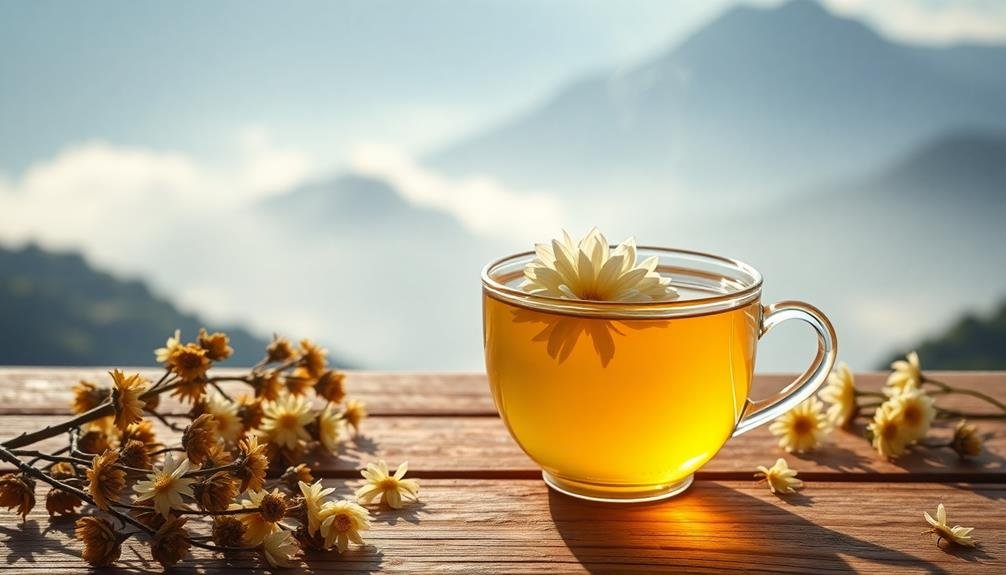
Although its exact origins are debated, chrysanthemum tea has been a staple in Chinese culture for over 1,600 years.
You'll find its roots deeply embedded in Traditional Chinese Medicine, where it's been used to treat various ailments, particularly those related to the eyes and liver.
The tea's popularity spread during the Song Dynasty (960-1279 AD), when it became a favorite among scholars and artists.
They believed it could enhance mental clarity and creativity. As you explore its history, you'll discover that chrysanthemum tea was initially reserved for the elite, but gradually became accessible to the general population.
You might be surprised to learn that the use of chrysanthemums in beverages extends beyond China.
In Korea, it's known as "gukhwacha," while in Japan, it's called "kiku-cha." Each culture has developed its own unique preparation methods and consumption rituals.
Today, you can enjoy chrysanthemum tea worldwide, with various blends and preparations available.
Its journey from ancient medicinal remedy to popular modern beverage showcases the enduring appeal of this floral infusion.
Nutritional Profile
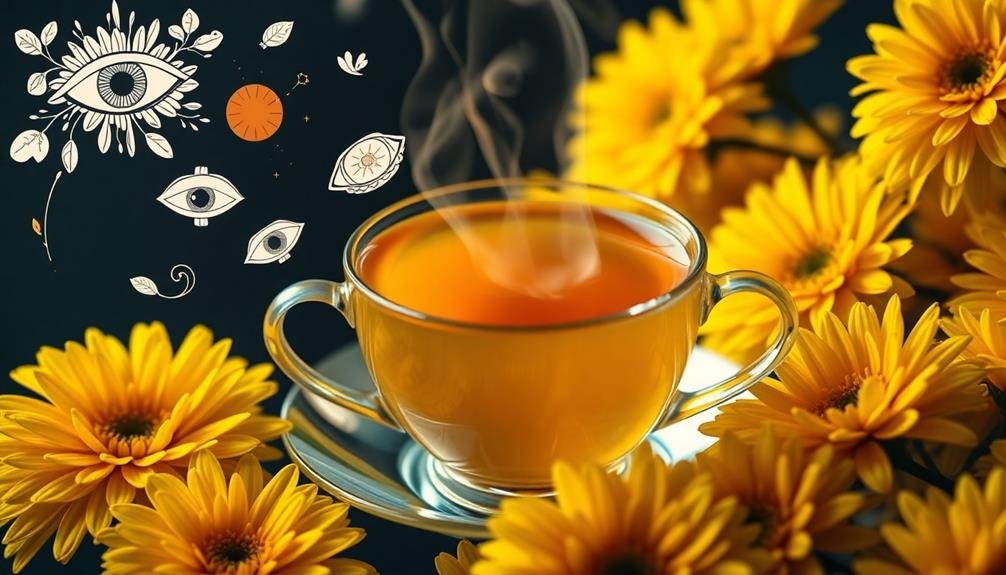
Chrysanthemum tea boasts a rich nutritional profile that contributes to its health benefits. You'll find it packed with essential vitamins, minerals, and antioxidants that support overall health and well-being.
This herbal infusion contains vitamin C, which boosts your immune system and promotes collagen production for healthy skin. It's also a good source of beta-carotene, a precursor to vitamin A, essential for maintaining eye health and vision.
The tea is rich in potassium, calcium, and magnesium, which support heart health, bone strength, and muscle function. You'll also benefit from its B-complex vitamins, including folate, niacin, and riboflavin, which play significant roles in energy metabolism and cellular health.
Chrysanthemum tea contains flavonoids and other antioxidants that help protect your cells from oxidative stress and inflammation. These compounds may contribute to its potential anti-cancer properties and ability to support liver health.
Additionally, you'll find amino acids in chrysanthemum tea that can help reduce stress and promote relaxation. With its low calorie content and absence of caffeine, this tea offers a healthy alternative to sugary drinks while providing numerous nutritional benefits.
Vision-Enhancing Properties
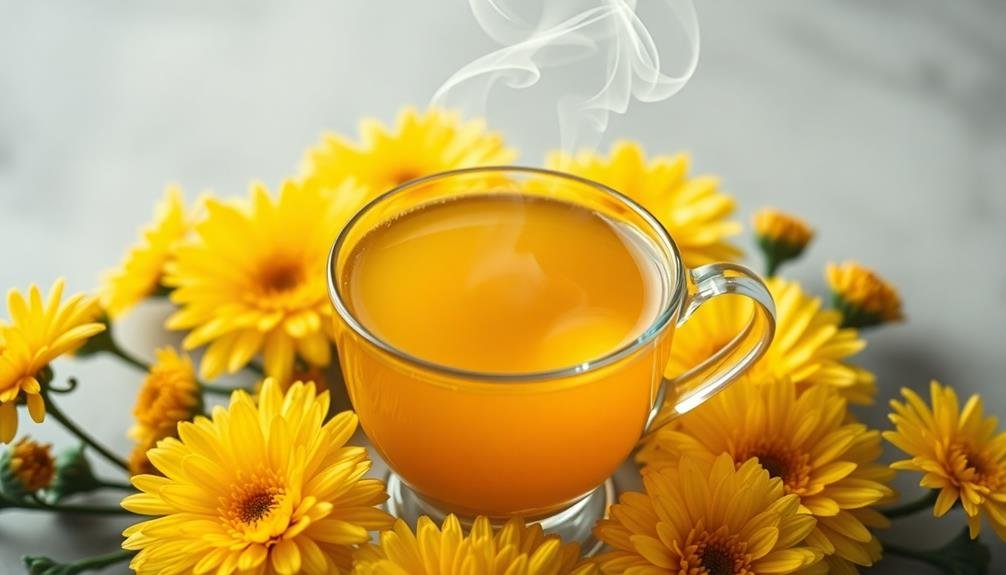
Beyond its nutritional benefits, chrysanthemum tea offers remarkable vision-enhancing properties. This herbal brew contains lutein and zeaxanthin, two powerful antioxidants that play an essential role in maintaining eye health. These compounds accumulate in the macula, the part of your retina responsible for sharp, detailed vision.
By drinking chrysanthemum tea regularly, you're supporting your eyes' natural defense against harmful blue light and oxidative stress. This protection can help reduce the risk of age-related macular degeneration and cataracts, two common causes of vision loss in older adults.
The tea's anti-inflammatory properties also contribute to eye health by reducing inflammation in the ocular tissues. This can alleviate symptoms of dry eye syndrome and promote overall eye comfort.
Additionally, chrysanthemum tea may help improve visual acuity and night vision. Some studies suggest that the antioxidants in the tea can enhance the eyes' ability to adapt to different light conditions, potentially improving your vision in low-light environments.
While chrysanthemum tea isn't a substitute for regular eye check-ups or a balanced diet, incorporating it into your routine can be a natural way to support your eye health and potentially enhance your vision.
Antioxidant-Rich Beverage
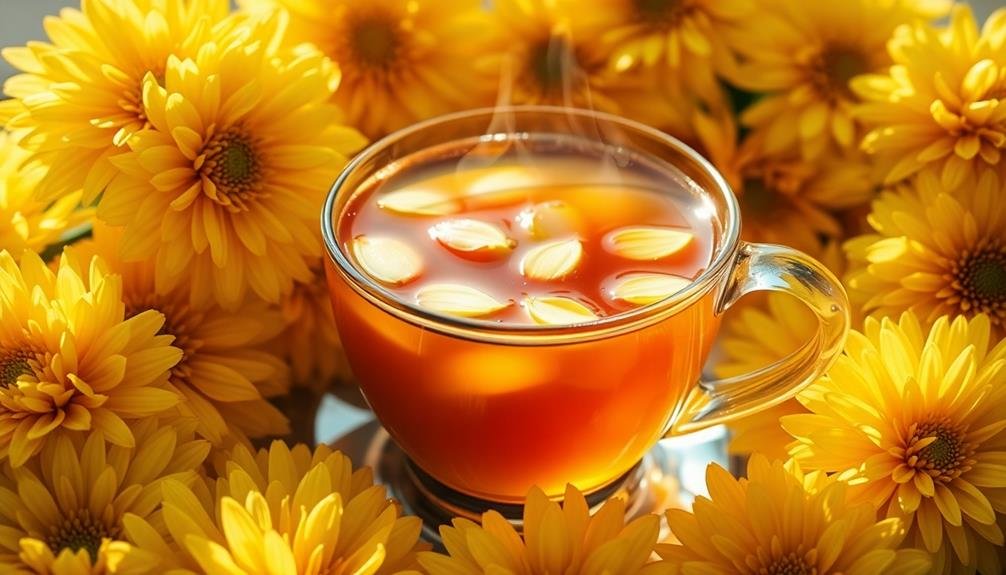
When you sip chrysanthemum tea, you're treating your body to a potent dose of antioxidants. These powerful compounds help protect your cells from damage caused by free radicals, which can lead to premature aging and various diseases.
Chrysanthemum tea is particularly rich in flavonoids, a type of antioxidant known for its anti-inflammatory and immune-boosting properties.
You'll find that this tea contains a variety of antioxidants, including quercetin, luteolin, and apigenin. These compounds work together to neutralize harmful molecules in your body, potentially reducing your risk of chronic conditions like heart disease and certain cancers.
The antioxidants in chrysanthemum tea may also help improve your skin's health, giving you a more youthful appearance.
Brewing the Perfect Cup
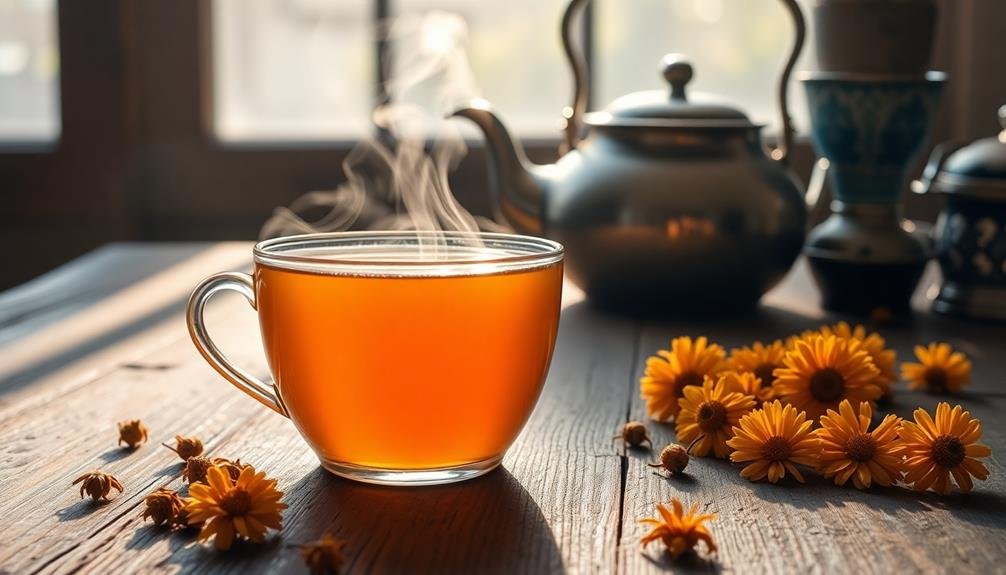
To brew the perfect cup of chrysanthemum tea, you'll need to take into account both steeping time and temperature.
You can use either dried or fresh flowers, with each offering slightly different flavor profiles.
For best results, steep dried flowers in water just below boiling for 3-5 minutes, while fresh flowers may require a longer infusion time of 5-7 minutes to fully release their essence.
Steeping Time and Temperature
Brewing the perfect cup of chrysanthemum tea requires careful attention to steeping time and temperature. For ideal flavor and health benefits, you'll want to use water that's just shy of boiling, around 195°F (90°C). This temperature allows the delicate chrysanthemum flowers to release their essence without becoming bitter.
As for steeping time, aim for 3 to 5 minutes. This duration guarantees that you extract the maximum flavor and beneficial compounds without over-steeping, which can lead to a bitter taste. If you prefer a stronger brew, you can extend the steeping time slightly, but be cautious not to exceed 7 minutes.
To help you visualize the perfect brewing process, imagine:
- Golden chrysanthemum buds unfurling in clear, steaming water
- A gentle aroma wafting from your cup, reminiscent of sweet flowers and honey
- The liquid gradually turning a pale, amber hue as it steeps
Dried vs. Fresh Flowers
Chrysanthemum tea's preparation offers a choice between dried and fresh flowers, each with its own unique characteristics. Dried chrysanthemum flowers are more commonly used and widely available. They're convenient, have a longer shelf life, and offer a concentrated flavor. When using dried flowers, you'll need fewer buds per cup compared to fresh ones.
Fresh chrysanthemum flowers, on the other hand, provide a more delicate and nuanced taste. They're often preferred for their vibrant aroma and subtle sweetness. If you have access to fresh chrysanthemums, you'll need to use more flowers to achieve the desired strength. However, fresh flowers are more perishable and should be used quickly after harvesting.
When brewing with dried flowers, you'll find they rehydrate quickly and release their flavors efficiently. Fresh flowers may require a slightly longer steeping time to extract their full essence.
Regardless of your choice, verify you're using food-grade chrysanthemums free from pesticides. Some tea enthusiasts enjoy mixing dried and fresh flowers to create a balanced flavor profile. Experiment with both options to discover your preferred taste and aroma in your chrysanthemum tea.
Cooling Effects on Eyes
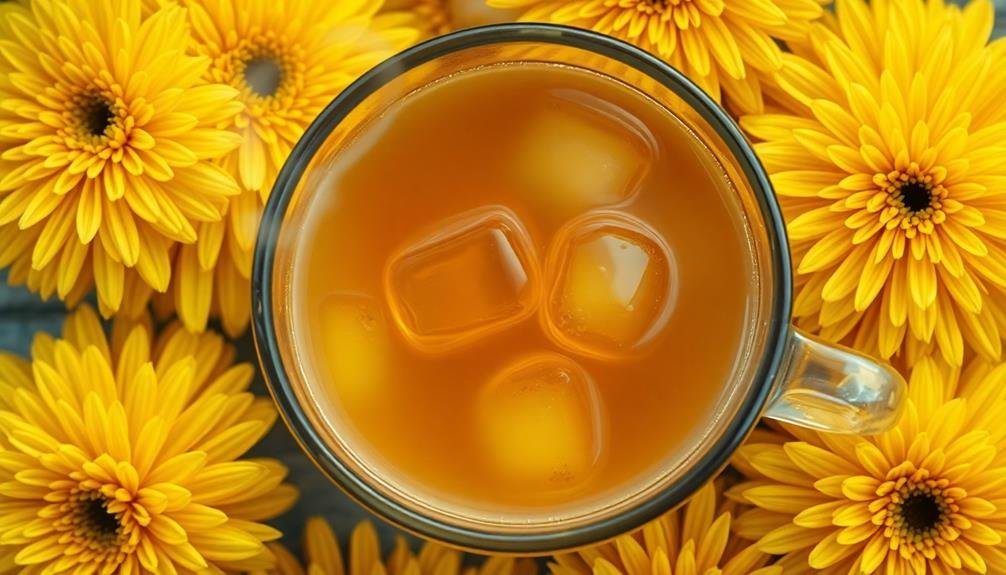
Along with its invigorating taste, chrysanthemum tea offers a cooling effect on the eyes. This soothing property has made it a popular remedy for eye-related discomfort in traditional Chinese medicine. When you consume chrysanthemum tea, you're tapping into its natural ability to reduce eye strain and inflammation.
The tea's cooling effects stem from its rich content of flavonoids and antioxidants. These compounds work to:
- Decrease eye redness and irritation
- Alleviate dryness and itchiness
- Improve overall eye comfort
You'll find that regularly drinking chrysanthemum tea can help combat the effects of prolonged screen time and environmental stressors on your eyes. It's particularly beneficial if you spend long hours in front of computers or in air-conditioned environments.
To maximize the cooling benefits for your eyes, you can also apply cooled chrysanthemum tea bags directly to your closed eyelids. This topical application allows the tea's active compounds to penetrate the delicate skin around your eyes, providing immediate relief and reducing puffiness.
Traditional Chinese Medicine Applications
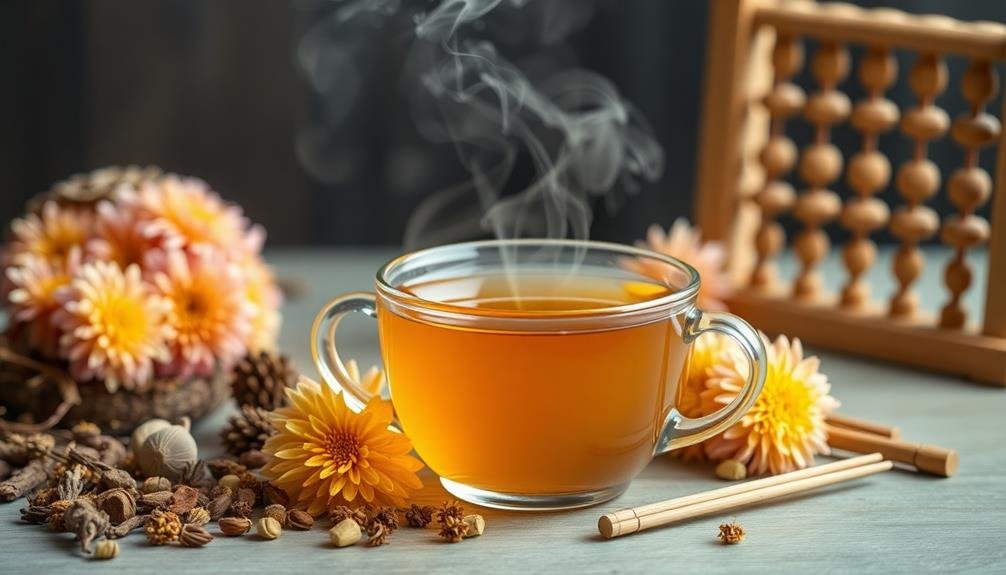
Traditional Chinese Medicine (TCM) has long embraced chrysanthemum tea for its diverse therapeutic properties. In TCM, this golden brew is classified as a cooling herb, believed to dispel heat and toxins from your body.
You'll find it's commonly used to address various ailments, particularly those related to the liver and eyes. When you're feeling feverish or experiencing headaches, TCM practitioners might recommend chrysanthemum tea to help reduce inflammation and soothe your symptoms.
It's also thought to support liver function, promoting detoxification and improving overall health. If you're dealing with high blood pressure, this tea could be beneficial, as it's believed to have mild hypotensive effects.
For respiratory issues, chrysanthemum tea is often suggested to relieve coughs and sore throats. Its anti-inflammatory properties may help ease symptoms of allergies and sinusitis.
In TCM, it's also used to promote longevity and maintain youthful skin. You might find it recommended for treating acne or other skin conditions due to its purported ability to clear heat and toxins from the body.
Seasonal Consumption Patterns
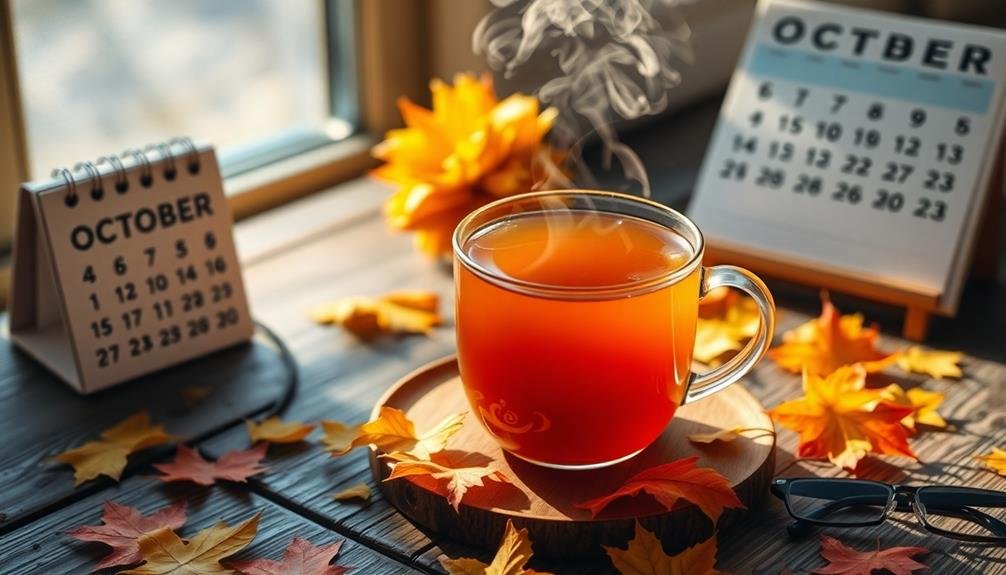
While chrysanthemum tea offers year-round benefits, its consumption patterns often shift with the seasons. You'll find that many people reach for this floral brew more frequently during the warmer months. Its cooling properties make it a popular choice to combat summer heat and humidity.
In traditional Chinese medicine, chrysanthemum tea is believed to dispel "internal heat," making it particularly appealing when temperatures rise.
During autumn, you might notice an uptick in chrysanthemum tea consumption as the flowers come into bloom. This season is often associated with chrysanthemums in many cultures, and drinking the tea becomes a way to celebrate the flower's natural cycle.
In winter and spring, you'll still find people enjoying chrysanthemum tea, but perhaps for different reasons:
- Winter: To boost immunity and ward off colds
- Spring: To cleanse the body and prepare for the warmer months ahead
- Year-round: To support eye health and relieve visual fatigue
Pairing With Other Herbs
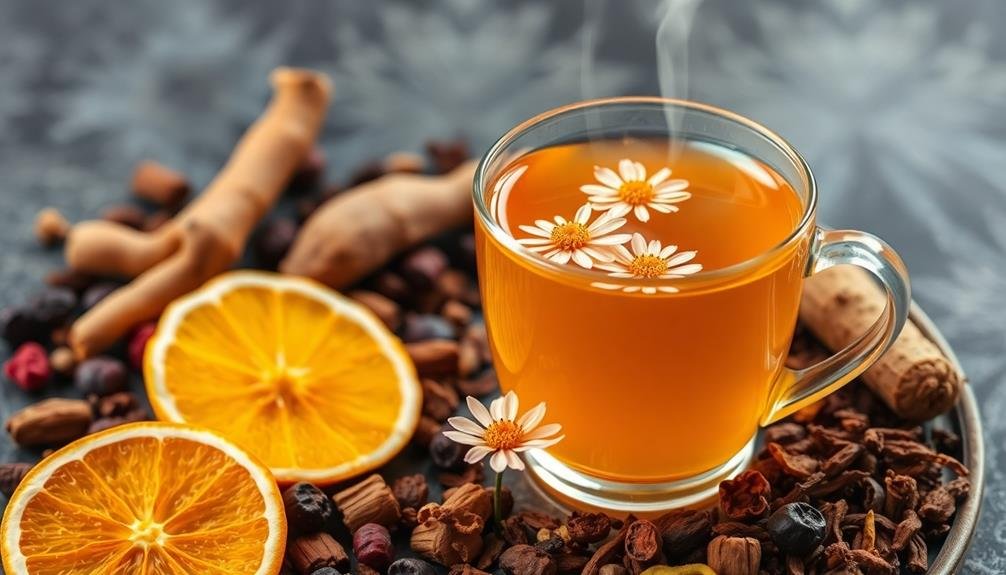
When you explore complementary herbal blends, you'll discover chrysanthemum tea pairs well with various herbs, enhancing its unique flavor profile.
You can combine it with goji berries for a sweet-tart twist or mix it with mint for a revitalizing coolness.
Complementary Herbal Blends
Herbalists and tea enthusiasts often pair chrysanthemum tea with other herbs to create unique and flavorful blends. These combinations not only enhance the taste but also boost the potential health benefits.
When exploring complementary herbal blends, you'll find that certain herbs work particularly well with chrysanthemum's delicate floral notes.
Consider trying these popular chrysanthemum tea blends:
- Chrysanthemum and goji berry: This combination offers a sweet and slightly tangy flavor while potentially enhancing eye health and immune function.
- Chrysanthemum and honeysuckle: A fragrant blend that may provide additional cooling and detoxifying properties.
- Chrysanthemum and mint: This invigorating mix can offer a soothing effect on the digestive system while promoting relaxation.
When creating your own blends, start with a base of chrysanthemum tea and experiment with small amounts of complementary herbs. You'll want to balance the flavors without overpowering the chrysanthemum's subtle taste.
Remember that some herbs may interact with medications or have contraindications, so it's wise to consult with a healthcare professional before incorporating new herbal blends into your routine, especially if you have any existing health conditions.
Enhancing Flavor Profiles
Enhancing the flavor profile of chrysanthemum tea can be achieved by carefully pairing it with complementary herbs and ingredients. You'll find that the subtle, floral notes of chrysanthemum blend well with a variety of flavors, allowing you to create unique and delightful combinations.
Consider pairing chrysanthemum tea with herbs like goji berries, which add a sweet-tart flavor and boost the tea's antioxidant properties. Honey or rock sugar can enhance the natural sweetness of chrysanthemum, while a touch of lemon or lime adds a revitalizing citrus twist.
| Herb/Ingredient | Flavor Profile | Health Benefits |
|---|---|---|
| Goji Berries | Sweet-tart | Antioxidants |
| Honey | Sweet | Antibacterial |
| Lemon | Citrus | Vitamin C |
For a more complex flavor, try adding a small amount of ginger or mint to your chrysanthemum tea. These herbs not only complement the floral notes but also provide additional health benefits. Ginger adds a warming, spicy element and aids digestion, while mint contributes a cool, invigorating taste and supports respiratory health.
Synergistic Health Benefits
Pairing chrysanthemum tea with other herbs can create powerful synergistic health benefits. By combining this vision-boosting elixir with carefully selected herbal companions, you'll enhance its effectiveness and expand its range of health-promoting properties.
Consider these popular pairings:
- Goji berries: Rich in antioxidants, they complement chrysanthemum's eye-protective qualities and may boost immune function.
- Honeysuckle: Known for its anti-inflammatory properties, it can enhance chrysanthemum's cooling effects and support respiratory health.
- Ginger: This warming herb balances chrysanthemum's cooling nature and may improve digestion and circulation.
When you blend chrysanthemum with these herbs, you're not just adding flavors; you're creating a potent brew that targets multiple aspects of your health.
For example, combining chrysanthemum and goji berries can provide a double dose of eye-supporting nutrients, potentially reducing the risk of age-related vision problems. Adding honeysuckle might help soothe a sore throat while amplifying chrysanthemum's fever-reducing properties.
Potential Side Effects
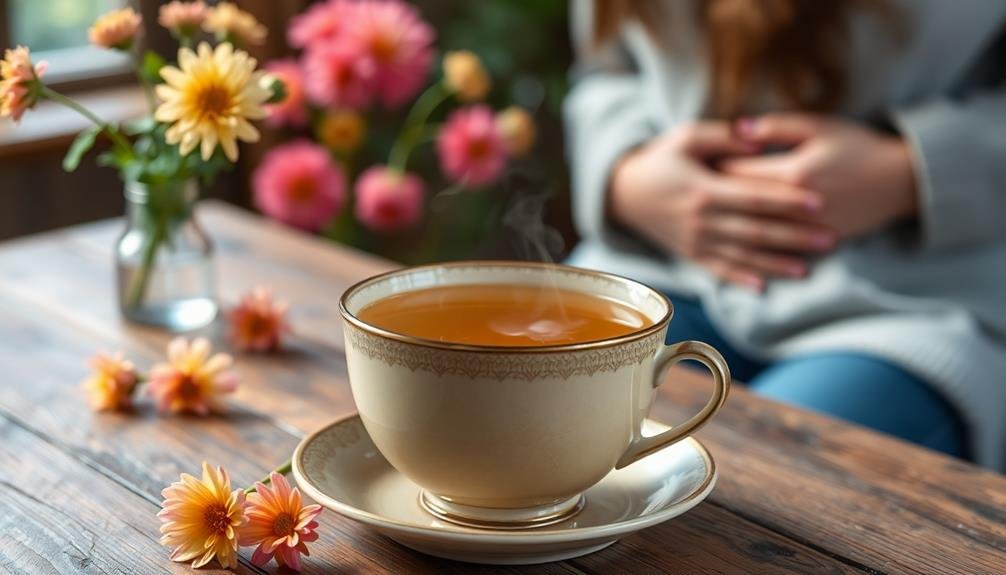
While generally considered safe, chrysanthemum tea can cause side effects in some people. If you're allergic to ragweed or other plants in the Asteraceae family, you might experience allergic reactions when consuming chrysanthemum tea. These can range from mild symptoms like itching and skin rashes to more severe reactions like difficulty breathing or anaphylaxis in rare cases.
You should also be cautious if you're taking certain medications. Chrysanthemum tea may interact with blood thinners, potentially increasing your risk of bleeding. It can also interfere with the effectiveness of some antibiotics and diabetes medications.
If you're pregnant or breastfeeding, it's best to avoid chrysanthemum tea due to limited research on its safety in these situations.
Some people might experience digestive discomfort, such as nausea or stomach upset, when drinking chrysanthemum tea. In rare instances, it can cause photosensitivity, making your skin more sensitive to sunlight.
If you're planning to drink chrysanthemum tea regularly, it's wise to consult with your healthcare provider, especially if you have any pre-existing medical conditions or are taking medications.
Sourcing Quality Chrysanthemum Flowers

Obtaining high-quality chrysanthemum flowers is essential for brewing the best tea. You'll want to source your flowers from reputable suppliers who specialize in organic, pesticide-free chrysanthemums. Look for flowers that are vibrant in color, with fully opened petals and a fresh, pleasant aroma. Avoid any that appear wilted, discolored, or have a musty smell.
When selecting chrysanthemum flowers, consider the following characteristics:
- Appearance: Choose flowers with intact, unblemished petals and a uniform shape.
- Dryness: Opt for flowers that are completely dry to prevent mold growth during storage.
- Size: Select larger blooms, as they often have a more concentrated flavor.
You can find quality chrysanthemum flowers at specialty tea shops, Asian markets, or through online retailers. If possible, buy whole flowers rather than pre-packaged tea bags to guarantee freshness and potency.
Store your chrysanthemum flowers in an airtight container away from light and moisture to maintain their quality. By sourcing high-quality flowers, you'll be able to enjoy the full range of flavors and health benefits that chrysanthemum tea has to offer.
Iced vs. Hot Preparation

You'll find that temperature plays an essential role in chrysanthemum tea preparation, affecting both nutrient retention and flavor profile.
Your choice between hot and iced versions may depend on seasonal preferences, with hot tea typically favored in cooler months and iced tea in warmer weather.
When preparing iced chrysanthemum tea, you'll need to adjust brewing times to account for dilution from ice, often steeping the tea longer or making a concentrate.
Temperature Affects Nutrient Retention
The temperature at which chrysanthemum tea is prepared can considerably impact its nutrient content. When you brew chrysanthemum tea at high temperatures, you'll extract more compounds quickly, but you might also degrade some heat-sensitive nutrients.
Conversely, cold brewing can preserve more delicate compounds but may not extract as many beneficial elements.
To maximize nutrient retention, consider these factors:
- Water temperature: Aim for 175-185°F (79-85°C) for hot brewing, as this range balances extraction and preservation.
- Steeping time: Extend cold brew time to 8-12 hours for better extraction without heat damage.
- Storage method: Keep brewed tea in an airtight container in the refrigerator to maintain freshness and nutrient content.
Hot-brewed chrysanthemum tea typically yields higher levels of antioxidants like flavonoids and phenolic compounds. However, it may lose some vitamin C due to heat exposure.
Cold-brewed tea retains more vitamin C but might have lower overall antioxidant levels. If you're looking to boost your eye health, you'll want to focus on preserving lutein and zeaxanthin, two carotenoids that are relatively heat-stable.
Ultimately, both hot and cold methods can provide health benefits, so choose based on your preferences and specific nutritional goals.
Seasonal Serving Preferences
Seasons play a significant role in how people prefer to enjoy their chrysanthemum tea. In warmer months, you'll often find yourself reaching for a rejuvenating glass of iced chrysanthemum tea, while colder seasons call for a comforting hot brew.
During summer, iced chrysanthemum tea offers a cooling respite from the heat. You can prepare it by steeping the flowers in hot water, then chilling the infusion before serving over ice. Add a splash of lemon or honey for extra flavor. In contrast, winter's chill is best combated with a steaming cup of hot chrysanthemum tea, which can warm you from the inside out.
Here's a quick guide to seasonal chrysanthemum tea preferences:
| Season | Hot/Iced | Preparation | Additions |
|---|---|---|---|
| Spring | Both | Light steep | Fresh mint |
| Summer | Iced | Cold brew | Citrus slices |
| Fall | Hot | Strong steep | Cinnamon stick |
| Winter | Hot | Long steep | Honey or ginger |
Brewing Time Differences
When preparing chrysanthemum tea, brewing times can vary considerably between hot and iced methods.
For hot chrysanthemum tea, you'll want to steep the flowers in water that's just below boiling (around 195°F or 90°C) for about 3-5 minutes. This allows the delicate flavors to infuse without becoming bitter. If you prefer a stronger taste, you can extend the steeping time to 7 minutes, but be cautious not to overdo it.
For iced chrysanthemum tea, you'll need to use a different approach. Start by brewing a concentrated hot tea, steeping the flowers for 5-7 minutes. Then, dilute it with cold water and ice. Alternatively, you can cold brew the tea by steeping the flowers in room temperature water for 4-6 hours in the refrigerator.
Here's what you'll notice with proper brewing:
- A light golden color
- A subtle, sweet aroma
- A rejuvenating, floral taste
Daily Intake Recommendations
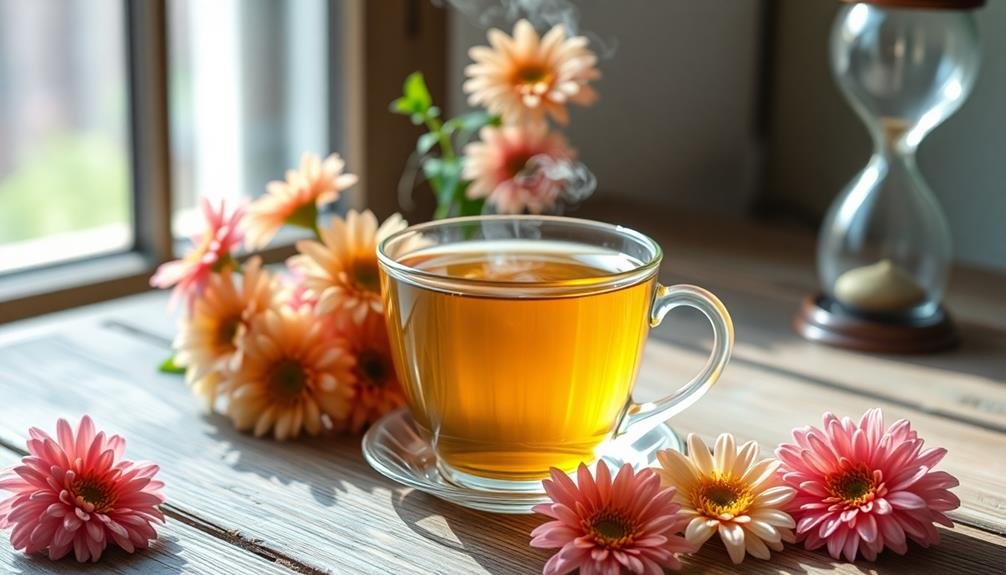
While chrysanthemum tea offers numerous health benefits, it's important to consume it in moderation. Most experts recommend drinking 1-3 cups of chrysanthemum tea per day to reap its vision-boosting and antioxidant properties without overdoing it.
You should start with one cup daily and gradually increase your intake if desired. Pay attention to how your body responds, as some people may be more sensitive to its effects.
If you're pregnant, nursing, or have any existing medical conditions, consult your healthcare provider before adding chrysanthemum tea to your routine.
It's best to space out your consumption throughout the day rather than drinking multiple cups at once. This allows your body to absorb the beneficial compounds more efficiently.
You can enjoy a cup in the morning for a gentle caffeine-free wake-up, another in the afternoon to combat eye strain, and one in the evening to promote relaxation.
Remember that chrysanthemum tea shouldn't replace water in your daily fluid intake. Maintain proper hydration by drinking plenty of water alongside your tea consumption for ideal health benefits.
Chrysanthemum Tea Eye Compress

You can create a soothing eye compress using cooled chrysanthemum tea to potentially reduce eye strain and puffiness.
To prepare, steep the tea, let it cool, then soak a clean cloth in the liquid before gently applying it to your closed eyes for 10-15 minutes.
For best results, use this remedy regularly and make certain you're using a fresh, clean cloth each time to avoid introducing bacteria to your eye area.
Preparation and Application
Looking for a soothing eye treatment? Chrysanthemum tea eye compresses are easy to prepare and apply at home.
First, brew a strong cup of chrysanthemum tea using 2-3 tea bags or 2 tablespoons of dried flowers in hot water. Let it steep for 10-15 minutes, then strain and allow it to cool to room temperature.
While the tea cools, gather these items:
- Clean, soft cotton pads or washcloths
- A small bowl
- A timer or clock
Once the tea has cooled, pour it into the bowl. Dip the cotton pads or washcloths into the tea, gently squeeze out excess liquid, and place them over your closed eyes. Relax and keep the compress on for 10-15 minutes. For best results, use this treatment twice daily.
You can enhance the compress's effectiveness by storing the cooled tea in the refrigerator for an extra cooling effect.
If you have sensitive skin, do a patch test before applying the compress to your eyes. Remember to discard any unused tea after 24 hours and make a fresh batch for each use to guarantee maximum benefits and hygiene.
Benefits for Eyes
Chrysanthemum tea eye compresses offer several benefits for eye health and comfort. When you apply a cool compress made from steeped chrysanthemum tea, you'll experience a soothing effect that can help reduce eye strain and fatigue.
The natural anti-inflammatory properties of chrysanthemum flowers work to decrease puffiness and redness around your eyes, providing relief from irritation.
These compresses can also help alleviate symptoms of dry eye syndrome by promoting tear production and moisturizing the delicate skin around your eyes.
The antioxidants present in chrysanthemum tea, such as flavonoids and vitamin C, may protect your eyes from free radical damage and support overall eye health.
Using chrysanthemum tea compresses regularly can improve blood circulation in the eye area, potentially reducing the appearance of dark circles.
Additionally, the compress's cooling effect may help constrict blood vessels, minimizing the look of bloodshot eyes.
Some users report that these compresses can help relieve headaches associated with eye strain.
While not a substitute for professional medical care, incorporating chrysanthemum tea eye compresses into your routine can be a natural and effective way to support your eye health and comfort.
Best Practices Tips
To maximize the benefits of a chrysanthemum tea eye compress, it's essential to follow some best practices. First, verify you're using high-quality, organic chrysanthemum flowers to brew your tea. Steep the flowers in hot water for about 5-10 minutes, then allow the tea to cool completely before using it as an eye compress.
When applying the compress, use a clean, soft cloth or cotton pad soaked in the cooled tea. Gently place it over your closed eyes for 10-15 minutes. For best results, repeat this process twice daily, preferably in the morning and evening.
Here are some additional tips to enhance your chrysanthemum tea eye compress experience:
- Store unused tea in an airtight container in the refrigerator for up to 48 hours
- Use fresh tea for each application to prevent bacterial growth
- Combine chrysanthemum tea with other herbs like chamomile or eyebright for added benefits
Remember to be consistent with your routine to see noticeable improvements in eye health. If you experience any irritation or discomfort, discontinue use and consult an eye care professional.
With regular use, you'll likely notice reduced eye strain, improved clarity, and overall better eye comfort.
Frequently Asked Questions
Can Pregnant Women Safely Drink Chrysanthemum Tea?
You can generally drink chrysanthemum tea while pregnant, but it's best to consult your doctor first. Moderation is key, as excessive consumption might have unknown effects. Always prioritize your health and your baby's well-being during pregnancy.
Does Chrysanthemum Tea Have Any Caffeine Content?
You'll be glad to know chrysanthemum tea doesn't contain caffeine. It's naturally caffeine-free, making it a great choice if you're looking to reduce your caffeine intake or enjoy a soothing beverage before bed.
Can Chrysanthemum Tea Help With Allergies or Hay Fever?
You'll be pleased to know that chrysanthemum tea can help with allergies and hay fever. It's known to have anti-inflammatory properties that may reduce allergy symptoms. Give it a try; you might find relief from sneezing and itching.
How Long Can Brewed Chrysanthemum Tea Be Stored in the Refrigerator?
You can store brewed chrysanthemum tea in the refrigerator for up to 3-4 days. Make sure you keep it in an airtight container to maintain its freshness. It's best to consume it within this timeframe for ideal taste and benefits.
Are There Any Drug Interactions Associated With Consuming Chrysanthemum Tea?
You should be cautious when drinking chrysanthemum tea if you're taking certain medications. It can interact with blood thinners, antibiotics, and some antihypertensive drugs. Always consult your doctor about potential interactions with your prescriptions.
In Summary
You've discovered the eye-opening benefits of chrysanthemum tea. It's a natural vision booster packed with antioxidants and nutrients. Whether you prefer it hot or iced, brewing the perfect cup is easy. Remember to source quality flowers and enjoy it regularly for ideal results. Don't forget to try the soothing eye compress technique. With chrysanthemum tea, you're not just sipping a delicious beverage – you're nurturing your eye health naturally.

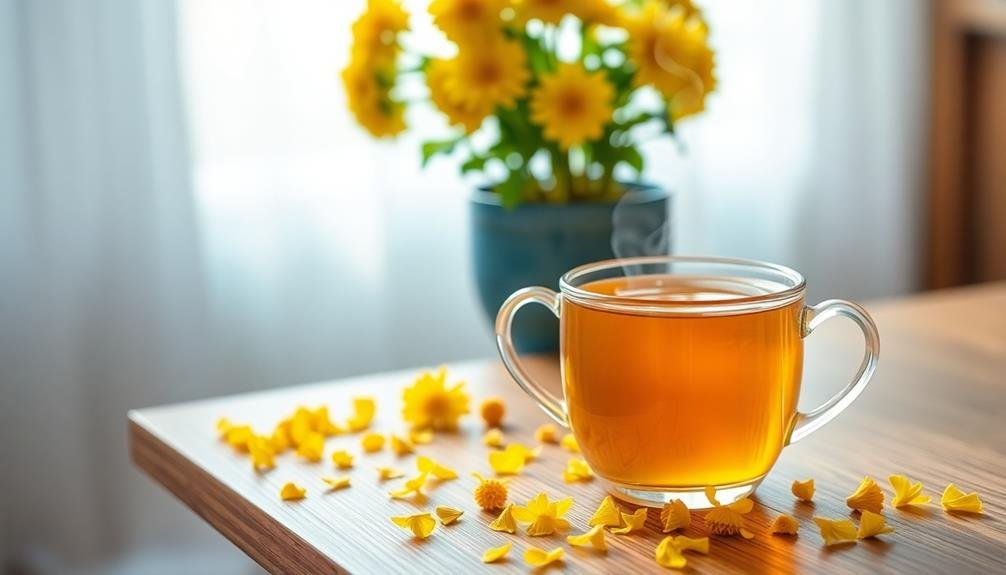
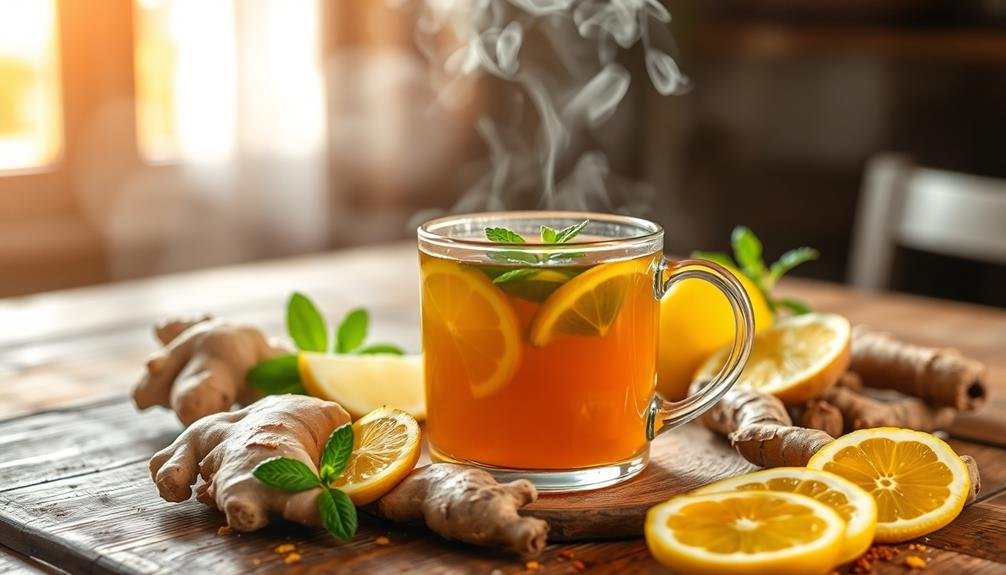
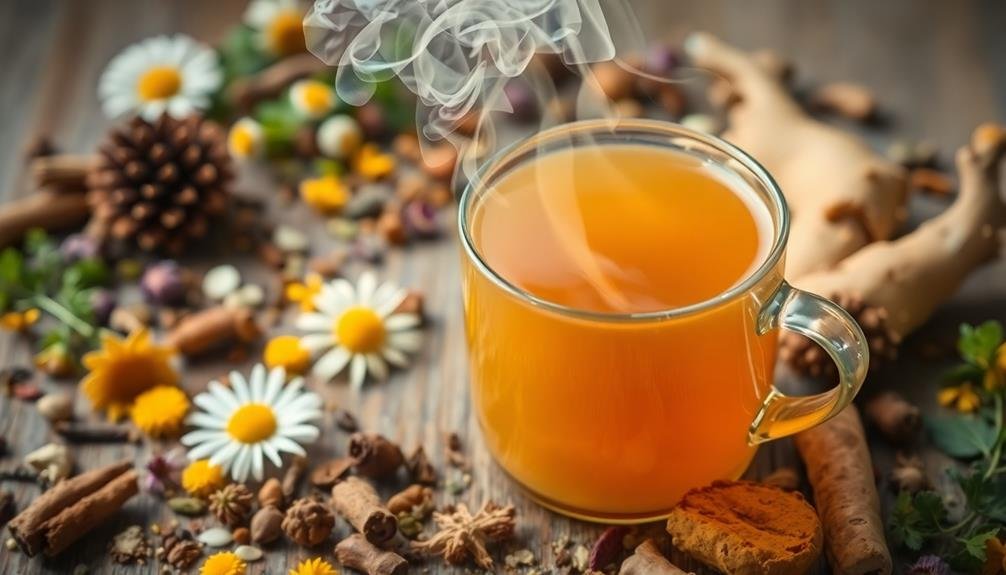
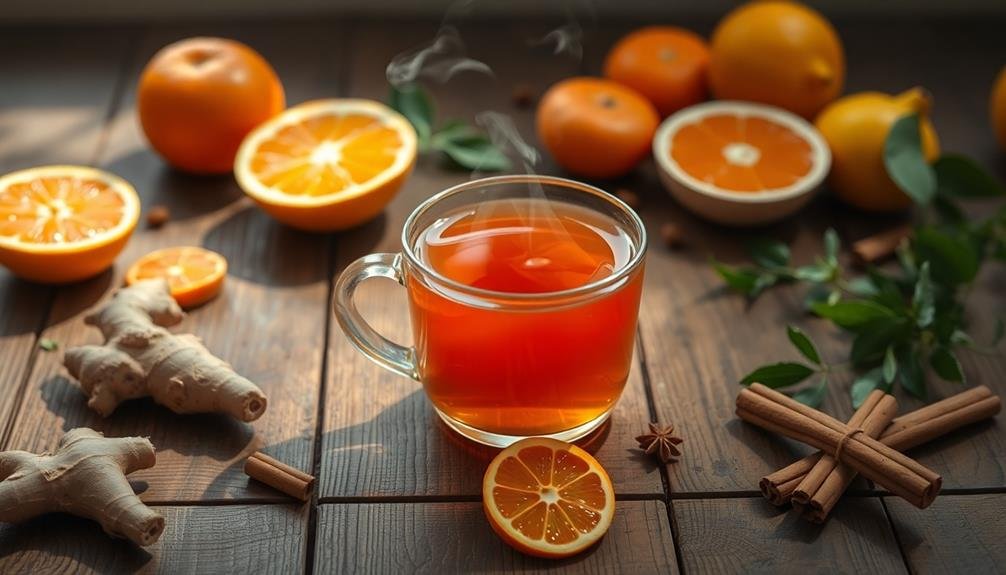
Leave a Reply